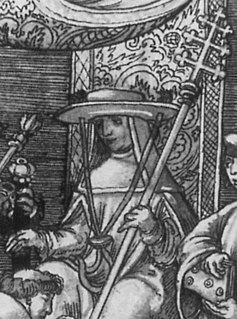Pope Anastasius IV, born Corrado Demetri della Suburra, was head of the Catholic Church and ruler of the Papal States from 8 July 1153 to his death. He is the most recent pope to take the name "Anastasius" upon his election.
Boso was an Italian prelate and Cardinal of the Roman Catholic church.
Theodwin was a German cardinal and papal legate of the 12th century.
Ubaldo Caccianemici was an Italian cardinal and cardinal-nephew of Pope Lucius II, his cousin who elevated him in May or June 1144.
Gregorio della Suburra was an Italian cardinal, created by Pope Innocent II in 1140 as priest of the title of S. Maria in Trastevere. He was nephew of Pope Anastasius IV, who promoted him to suburbicarian see of Sabina in September 1154. After the double papal election in September 1159 he supported the obedience of Pope Alexander III. He became Dean of the Sacred College of Cardinals in 1159, after the deposition of Cardinal Icmar of Tusculum, who had consecrated Antipope Victor IV (1159-1164) and joined his obedience. He was papal vicar at Rome in 1160. His name appears for the last time in the papal bull dated 20 September 1162.
Imar, O.S.B. Cluny was a French Benedictine abbot, who served as a bishop and cardinal.

The 1159 papal election followed the death of Pope Adrian IV. It resulted in a double papal election. A majority of the cardinals elected Cardinal Rolando of Siena as Pope Alexander III, but a minority refused to recognize him and elected their own candidate Ottaviano de Monticelli, who took the name Victor IV, creating a schism that lasted until 1178.

The 1154 papal election followed the death of Pope Anastasius IV and resulted in the election of Pope Adrian IV, the only Englishman to become pope.
Gerard de Namur was a cardinal born in Namur in the modern-day Belgium. In older historiography he is wrongly identified as Gerardo Caccianemici, nephew of Pope Lucius II.
The 1153 papal election followed the death of Pope Eugene III and resulted in the election of Pope Anastasius IV.

In the category of the members of the College of Cardinals in the central Middle Ages, an external cardinal was a Cardinal of the Holy Roman Church who did not reside in the Roman Curia, because of simultaneously being a bishop of the episcopal see other than suburbicarian, or abbot of an abbey situated outside Rome. In the wider sense, it may also concern cardinals who were appointed to the external episcopal sees and resigned their memberships in the College of Cardinals with this appointment. As well, it can concern cardinals who were generally curial cardinals, but for some time exercised the posts of administrators or prelates of the external churches.

The 1143 papal election followed the death of Pope Innocent II and resulted in the election of Pope Celestine II.

The 1144 papal election followed the death of Pope Celestine II and resulted in the election of Pope Lucius II.

The 1145 papal election followed the death of Pope Lucius II and resulted in the election of Pope Eugene III, the first pope of the Order of Cistercians.
Pope Eugene III (1145–1153) created sixteen cardinals in nine consistories:
Pope Lucius II (1144–1145) created eleven cardinals in two consistories.
Pope Celestine II (1143–1144) created nine cardinals in one consistory: